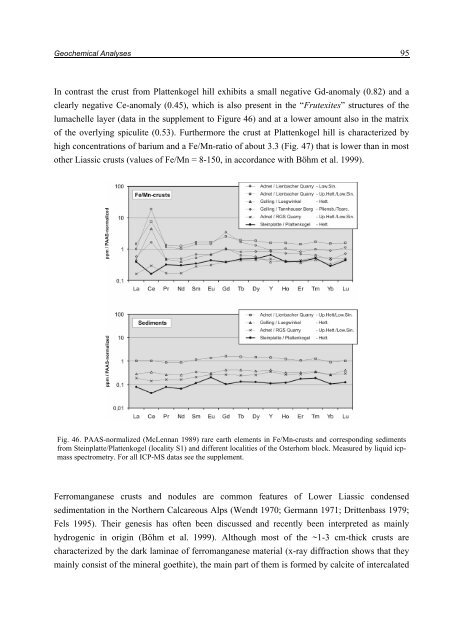Porifera-microbialites of the Lower Liassic (Northern Calcareous ...
Porifera-microbialites of the Lower Liassic (Northern Calcareous ...
Porifera-microbialites of the Lower Liassic (Northern Calcareous ...
Create successful ePaper yourself
Turn your PDF publications into a flip-book with our unique Google optimized e-Paper software.
Geochemical Analyses 95<br />
In contrast <strong>the</strong> crust from Plattenkogel hill exhibits a small negative Gd-anomaly (0.82) and a<br />
clearly negative Ce-anomaly (0.45), which is also present in <strong>the</strong> “Frutexites” structures <strong>of</strong> <strong>the</strong><br />
lumachelle layer (data in <strong>the</strong> supplement to Figure 46) and at a lower amount also in <strong>the</strong> matrix<br />
<strong>of</strong> <strong>the</strong> overlying spiculite (0.53). Fur<strong>the</strong>rmore <strong>the</strong> crust at Plattenkogel hill is characterized by<br />
high concentrations <strong>of</strong> barium and a Fe/Mn-ratio <strong>of</strong> about 3.3 (Fig. 47) that is lower than in most<br />
o<strong>the</strong>r <strong>Liassic</strong> crusts (values <strong>of</strong> Fe/Mn = 8-150, in accordance with Böhm et al. 1999).<br />
Fig. 46. PAAS-normalized (McLennan 1989) rare earth elements in Fe/Mn-crusts and corresponding sediments<br />
from Steinplatte/Plattenkogel (locality S1) and different localities <strong>of</strong> <strong>the</strong> Osterhorn block. Measured by liquid icpmass<br />
spectrometry. For all ICP-MS datas see <strong>the</strong> supplement.<br />
Ferromanganese crusts and nodules are common features <strong>of</strong> <strong>Lower</strong> <strong>Liassic</strong> condensed<br />
sedimentation in <strong>the</strong> Nor<strong>the</strong>rn <strong>Calcareous</strong> Alps (Wendt 1970; Germann 1971; Drittenbass 1979;<br />
Fels 1995). Their genesis has <strong>of</strong>ten been discussed and recently been interpreted as mainly<br />
hydrogenic in origin (Böhm et al. 1999). Although most <strong>of</strong> <strong>the</strong> ~1-3 cm-thick crusts are<br />
characterized by <strong>the</strong> dark laminae <strong>of</strong> ferromanganese material (x-ray diffraction shows that <strong>the</strong>y<br />
mainly consist <strong>of</strong> <strong>the</strong> mineral goethite), <strong>the</strong> main part <strong>of</strong> <strong>the</strong>m is formed by calcite <strong>of</strong> intercalated

















